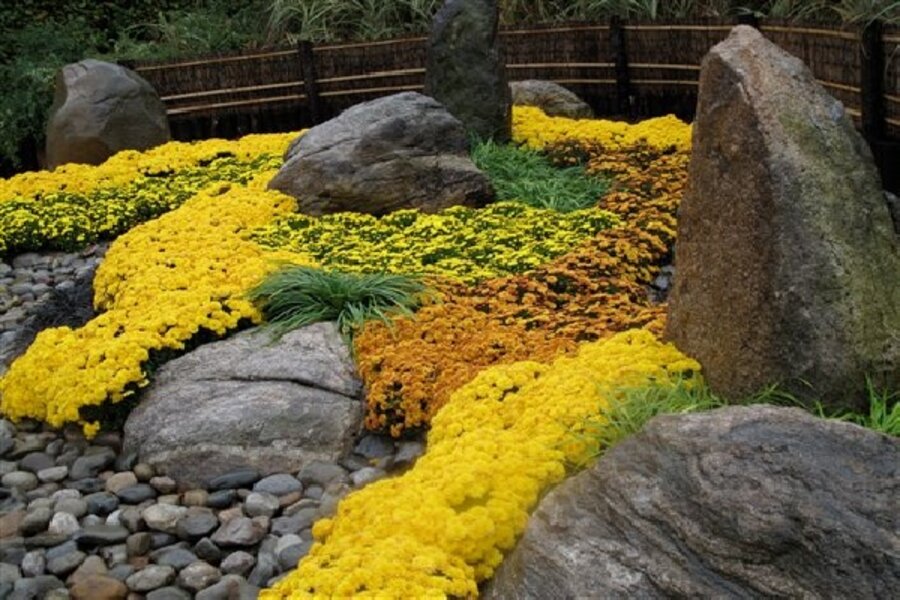The right rocks are essential for a rock garden
Choosing the right rocks can be as much fun as selecting plants when you're building a rock garden.
Stones create protective wind and sun barriers, and pockets of moisture for small, low-growing alpine flowers. Meanwhile, they are contributing tones and textures all their own.
"The first line in the 'Sakuteiki,' the oldest and most respected treatise on how to design a garden in Japan, is about the art of setting stone," says Marc Peter Keane, a landscape architect and educator from Ithaca, N.Y. "Everything follows from there. Rocks are absolutely primary."
Rock placement must be done skillfully so that "even persons knowledgeable about natural formations cannot easily detect the artifice," wrote the late Thomas H. Everett, who was horticulture director and senior curator of education at The New York Botanical Garden, in an account posted on the North American Rock Garden Society Web site.
"Transported rocks must match precisely those of the site and be positioned as though placed by nature."
Availability often determines the kinds of rock you'll use.
"Where choice may be had, one that is porous, rather than such hard, impervious types as granite and schist, is to be preferred," Mr. Everett said. "Weathered pieces collected from the surface of the ground and of a character and color that suggest age are likely to be ideal."
More artistic flair is required for fashioning Japanese gardens than alpine ones, Mr. Keane says.
"With a Japanese garden, you don't try to create a garden that resembles nature as much as you try to distill it. You create the artwork that brings out some important (site) characteristics."
The rocks should be subdued, not lavish or colorful, says Keane, who designed the stone garden for the recent Kiku exhibition at The New York Botanical Garden. "They should have personalities but not be flamboyant."
It also is essential that Japanese gardens be enclosed in some type of courtyard or space, Keane says. "It's like putting a frame around them. You don't want them out in the landscape. They would be lost."
The best stones for rock gardens are any that fit your environment, says John Strickland, who with his wife, Nancy, owns and operates the Dry Creek Garden Co. in Reno, Nev.
"That's not only for aesthetic purposes but because they're so labor intensive to get," Mr. Strickland says. "The ideal rock is the one you have close by."
Angular rocks are easier to work with than round river rocks, he says. "You're talking about creating formations, things like streams and waterfalls, shelves and crevices. Rocks with lichens on them are a bonus. They give you a patina kind of look."
Ask, though, before you go about gathering rocks. "You'll generally get permission from people who don't assign any value to the rocks they have on their property," Strickland says. "If nothing else, some rocks are available for purchase and can be delivered."
Here are some Bureau of Land Management policies governing rock collecting on federal lands. Some areas, particularly campgrounds, cultural and historic sites, and natural areas are off-limits.
And you may need a permit or have to pay a fee, if you:
— Gather more than a pickup-truck load or make more than one trip.
— Remove more than 250 pounds of rocks.
— Make the material available for commercial use.
— Use power equipment or explosives to remove rocks from the ground.
Most rock gardens are designed for temperate areas where they mimic mountain conditions with sunny, wind-blown, and well-drained sites. But that doesn't mean you can't create a water-wise desert rock garden, adding succulents, conifers and cactus.
You also could build a rock garden if you're space deprived — living in an apartment, for instance. Alpine plants are small, colorful, and hardy, making them great for use in containers.
"Give them the drainage they need; the protection they need," Strickland says. "Create the right microclimates and you'll reduce maintenance chores. You'll only have to go out there and trim things or replant once in a while."
Editor’s note: For more on gardening, see the Monitor’s main gardening page, which offers articles on many gardening topics. Also, check out our blog archive and our RSS feed. You may want to visit Gardening With the Monitor on Flickr. Take part in the discussions and get answers to your gardening questions. If you join the group (it’s free), you can upload your garden photos and enter our contests.





